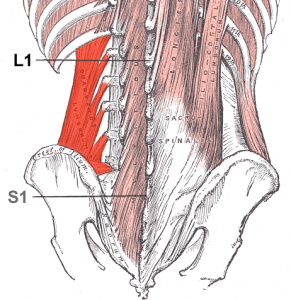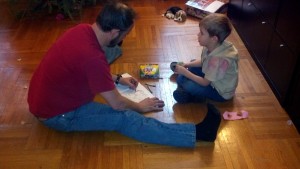The quadratus lumborum are two side bending muscles of the lower back on either side of the spine. As I talked about in last week’s posts quadrate muscles act as stabilizers and the quadratus lumborum helps to connect and stabilize the pelvis to the rib cage. The quadratus lumborum also, when working together, help to extend the lower spine along with the erector spinea and other spinal muscles. The quadratus lumborum also has a role in breathing and is intrinsic to walking as it hikes the hip a little with every successful step.
When I get a new client after looking at them standing and walking I always want to see how successfully they are at getting up and down off the floor. I am pushing fifty with two little kids and as a result I spend a good amount of time on the floor—very often in a wide legged straddle like upavista konasana. The other day my son and I spent an hour or so working on a Star Wars coloring book (I should say he told me what to color and I colored) and when I got up from sitting it felt as if my spare tire had solidified into cement.
This is what most people are doing all day at their desks. Even people who don’t have to tuck under and round their lower spine into the back of the chair do it anyway because it is easier than staying aware of sitting up straight.
That is what I mean by crunching the quadratus. I had basically sat hunched over with a tucked pelvis for way too long and my quadratus lumborum were registering their unhappiness. And who can blame them? When I sit that way, and when almost everyone I work with sits that way, the muscles of the lower spine, specifically the erector spinea and the mutifidus, two muscles that are meant to lengthen the spine upwards are taken out of the picture along with the curve of the lower back. When this happens the quadratus lumborum turns on permanently to help where the others can’t.
The psoas is involved as usual. For one, it is the next door neighbor of the quadratus lumborum so a problem with one always involves a problem with the other. The proper alignment of the psoas will keep the lumbar spine in its correct curve which will in turn allow the erector muscles of the spine to find tone and lengthen up. Without the curve the psoas major and the erector spinea can do their balancing act and as a result the erectors lose tone and the quadratus lumborum takes over.
The brain and body recruit the available muscle to accomplish a task if the appropriate muscle is not able to play. When the pelvis is tucked the lack of curve in the lumbar spine take the spinal erectors out of the functional picture and leaves the quadratus lumborum to do a poor job of replacing them.
The quadratus lumborum is the source of so much back pain but there is little it can do to change that without your help.
***



